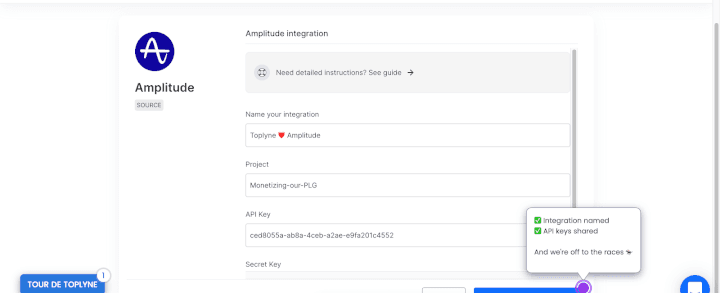PLG Marketing: What it is + 3 Steps to Execute it
PLG Marketing: What it is + 3 Steps to Execute it
PLG Marketing: What it is + 3 Steps to Execute it
What’s PLG marketing? How do you implement it? Discover the 3 key steps to executing a fast-growth PLG marketing strategy.
What’s PLG marketing? How do you implement it? Discover the 3 key steps to executing a fast-growth PLG marketing strategy.
What’s PLG marketing? How do you implement it? Discover the 3 key steps to executing a fast-growth PLG marketing strategy.



You’ve heard about product-led growth (PLG), a business strategy in which the product drives user acquisition, expansion, conversion, and retention.
And you’ve heard of marketing, of course.
But now, we’re fusing the two to form product led growth marketing!

We thought you’d ask.
In this article, we’ll cover what is PLG marketing and its characteristics. We’ll also highlight how you can implement a successful PLG marketing strategy.
Let’s begin!
What is PLG Marketing?
Product-led growth marketing is a customer acquisition approach that applies product-led growth strategy principles to marketing functions.
In other words, PLG marketing uses the product as its own sales and marketing tool by letting users experience its value first-hand.
The marketing team, customer success team, sales team, and product team don’t work in silos in a product-led company. Instead, in a PLG company, they work together 🤝 with the product at the center of marketing and the customer at the center of the product.
But that brings us to…
Why Should You Employ PLG Marketing?
For a software company or SaaS company, employing PLG marketing is like having an Instagram account. Everyone should be using it!
Not because it’s got cute dog videos 🐶 but because it can help your SaaS company:
Get a data-informed understanding of the entire customer journey.
Execute data-driven audience segmentation and targeting.
Dramatically improve customer conversion rates and customer success.
Spend less on sales and marketing without sacrificing the number of leads and conversions.
Request feedback, reviews, and other forms of social proof directly in-app.
Curious about the PLG strategy? Check out our ultimate product-led growth strategy guide.
Also, if you have a B2B marketing team, here are 5 ways you can leverage the PLG model!
Now before you say yes to PLG marketing, let’s check out what helps it stand out from traditional or sales led growth marketing.
Three Elements that make PLG Marketing So Cool!
Here are three key elements of product led approach for marketing:
1. Market Through the Product
For a PLG marketing team, the product is the main channel of communication with customers. This differs from sales led growth or traditional marketing, which relies heavily on ads, email marketing, content marketing, and more.
PLG marketing teams use in-app messaging to keep customers in the loop about feature releases, updates, and announcements. These announcements can also encourage users to dive deeper into the tool.

Additionally, when users interact with in-app messages, a marketer can monitor customer data like user behavior and preference. This data lets your marketing team deliver more targeted, contextual guidance and drive effective upsell opportunities!
Can you hear your marketing team sighing in relief yet? 😌
2. Rely on Product Data
Product analytics is a PLG marketing team’s elixir 🧪
It can help any product led growth team and product manager monitor user behaviors to make informed decisions about how to improve the product.
Product analytics data also helps them recognize key activation points that drive usage and conversions across their customer base.
Guess you should get ready to make bank! 💰
A product led growth marketer also uses product usage and customer sentiment insights to identify potential advocates and power users. They will then engage with them to collect reviews or testimonials, contributing to the virality of the product.

To recognize which existing customer is ready to go to the next level - from a power user to an advocate - check out our ultimate guide on Product Led Flywheel.
3. Value Freemium Users
Your product in a PLG approach is like a swiss knife 🔪 It can help with multiple things, such as sales and marketing.
But did you know: In a PLG strategy, the product can also nurture freemium users (existing users) into paying customers as they experience its value?
However, for at-scale customer acquisition, you’ll need a large number of free users to nurture.
Traditionally, your marketing team would address the pool of free users by creating dedicated organic acquisition channels such as referrals, affiliate programs, and SEO – to increase the number of potential customers.
However, the customer acquisition cost 💲will be high if you solely rely on this approach, and it will cost you time.
So PLG marketing teams market and sell to freemium users instead to increase conversion rates and expedite the upsell process.
Why wouldn’t they?
It’s easier with freemium users because they know your company and product. This means you can spend less time educating them. Moreover, with in-app messaging, they’re easy to target and reach.
Check out our ultimate guide on Product Led Sales to learn how to make the most out of every product qualified lead!
So are you ready to implement PLG marketing?
Let’s see how!
How to Implement a Successful PLG Marketing Strategy
It sure can sound intimidating to implement a successful product led growth marketing strategy.
Let’s face it, the strategy’s name is four words long!
But it’s actually very simple to implement – if you use Toplyne.
1. Automatically Identify Users Likely to Upgrade
Imagine a world where your product marketing and sales team know exactly which of your users are prime prospects for your paid plans! 🤔
You could take the action to convert them with:
In-app prompts
Targeted emails
Personalized demo offers
Discount offers
Sounds awesome, right?
Why not put your imagination into action by using a tool like Toplyne?
This tool can help your growth team automatically identify every potential customer who’s likely to convert in no time. 💃
Toplyne helps you:
Use your product analytics or product usage data to increase conversions within your freemium user base – by spotting the customers with the highest conversion potential.

Supply your SaaS sales team with relevant information to convert users into paid customers.
Experiment with diverse conversion strategies to execute your go to market strategy. You can opt for remarketing, automated messaging, sales-assist motions, and in-product nudges.

Integrate with your present marketing tools and product usage data (from Mixpanel, Amplitude, etc.) to focus on key business metrics. Toplyne uses the product data to examine active users with both high and low conversion potentials.

You can also integrate with email marketing automation tools like Clearbit and billing software like Stripe.
2. Create Self-Guided Tours
Self-guided tours allow users to check out a pre-programmed version of your product before creating an account or subscribing to a paid plan.
It’s like a virtual fitting to see if the outfit (product) works for you.

A self-guided tour is a powerful sales and marketing tool allowing new users to try and see what your product is like in action.
Users can test the product while clicking through real examples of common use cases. This familiarity also improves product adoption when users eventually sign up.
Self-guided tours are also perfect for customers who aren’t ready to talk to the sales team. Or those who aren’t a fan of traditional marketing messages — but are into learning about your offerings.
The best part?
Self-guided tours are always available and don’t need devoted attention from the marketing or sales teams. As a result, they scale exceptionally well while enhancing both the product experience and user experience.
3. Leverage In-App Guidance
In-app messaging lets product led companies communicate with customers and users through the product by displaying lightboxes, carousels, banners, etc.
Such messages can boost cross-sell and upsell initiatives, help collect user feedback, and get users past friction points. That’s because in-app messages pop up while the user is actively using the product, which makes customers respond to them more than push notifications or emails.
After all, we all know how hard it’s not to click on that ‘50% off on pizzas’ banner. 🍕🤤
In-app guidance can also help PLG marketing teams notify customers about:
Upcoming releases
New features
Tweaked product functionalities for a better user experience
News about helpful resources or events
Providing feedback or reviews
And more!
Keeping your customers, both old and new users, in the loop will help your PLG company, particularly the product team, improve product adoption and product experience. All of these eventually lead to scalable product growth, better customer lifetime value, and a satisfactory customer experience!
Did you know in-app messages can help with onboarding too?
Check out our product led onboarding guide to learn why onboarding is important for a PLG model.
PLG Marketing: Is This Growth Strategy Your Cup of Tea? ☕
PLG marketing ropes marketing professionals into every stage of product management, from onboarding and pricing to sales and expansion. It’s the ultimate cross-functional, omnichannel marketing strategy for user acquisition and product growth!
That’s why you also need a tool that’s just as dynamic to make sense of all the marketing and customer data you collect.
You need Toplyne.
It’ll draw data from your product analytics tool to help you find each and every potential customer and product qualified lead quickly, as well as employ your favorite go to market strategy.
Sign up for Toplyne for free today to make the most of your product marketing tactics and convert customers like never before!
You’ve heard about product-led growth (PLG), a business strategy in which the product drives user acquisition, expansion, conversion, and retention.
And you’ve heard of marketing, of course.
But now, we’re fusing the two to form product led growth marketing!

We thought you’d ask.
In this article, we’ll cover what is PLG marketing and its characteristics. We’ll also highlight how you can implement a successful PLG marketing strategy.
Let’s begin!
What is PLG Marketing?
Product-led growth marketing is a customer acquisition approach that applies product-led growth strategy principles to marketing functions.
In other words, PLG marketing uses the product as its own sales and marketing tool by letting users experience its value first-hand.
The marketing team, customer success team, sales team, and product team don’t work in silos in a product-led company. Instead, in a PLG company, they work together 🤝 with the product at the center of marketing and the customer at the center of the product.
But that brings us to…
Why Should You Employ PLG Marketing?
For a software company or SaaS company, employing PLG marketing is like having an Instagram account. Everyone should be using it!
Not because it’s got cute dog videos 🐶 but because it can help your SaaS company:
Get a data-informed understanding of the entire customer journey.
Execute data-driven audience segmentation and targeting.
Dramatically improve customer conversion rates and customer success.
Spend less on sales and marketing without sacrificing the number of leads and conversions.
Request feedback, reviews, and other forms of social proof directly in-app.
Curious about the PLG strategy? Check out our ultimate product-led growth strategy guide.
Also, if you have a B2B marketing team, here are 5 ways you can leverage the PLG model!
Now before you say yes to PLG marketing, let’s check out what helps it stand out from traditional or sales led growth marketing.
Three Elements that make PLG Marketing So Cool!
Here are three key elements of product led approach for marketing:
1. Market Through the Product
For a PLG marketing team, the product is the main channel of communication with customers. This differs from sales led growth or traditional marketing, which relies heavily on ads, email marketing, content marketing, and more.
PLG marketing teams use in-app messaging to keep customers in the loop about feature releases, updates, and announcements. These announcements can also encourage users to dive deeper into the tool.

Additionally, when users interact with in-app messages, a marketer can monitor customer data like user behavior and preference. This data lets your marketing team deliver more targeted, contextual guidance and drive effective upsell opportunities!
Can you hear your marketing team sighing in relief yet? 😌
2. Rely on Product Data
Product analytics is a PLG marketing team’s elixir 🧪
It can help any product led growth team and product manager monitor user behaviors to make informed decisions about how to improve the product.
Product analytics data also helps them recognize key activation points that drive usage and conversions across their customer base.
Guess you should get ready to make bank! 💰
A product led growth marketer also uses product usage and customer sentiment insights to identify potential advocates and power users. They will then engage with them to collect reviews or testimonials, contributing to the virality of the product.

To recognize which existing customer is ready to go to the next level - from a power user to an advocate - check out our ultimate guide on Product Led Flywheel.
3. Value Freemium Users
Your product in a PLG approach is like a swiss knife 🔪 It can help with multiple things, such as sales and marketing.
But did you know: In a PLG strategy, the product can also nurture freemium users (existing users) into paying customers as they experience its value?
However, for at-scale customer acquisition, you’ll need a large number of free users to nurture.
Traditionally, your marketing team would address the pool of free users by creating dedicated organic acquisition channels such as referrals, affiliate programs, and SEO – to increase the number of potential customers.
However, the customer acquisition cost 💲will be high if you solely rely on this approach, and it will cost you time.
So PLG marketing teams market and sell to freemium users instead to increase conversion rates and expedite the upsell process.
Why wouldn’t they?
It’s easier with freemium users because they know your company and product. This means you can spend less time educating them. Moreover, with in-app messaging, they’re easy to target and reach.
Check out our ultimate guide on Product Led Sales to learn how to make the most out of every product qualified lead!
So are you ready to implement PLG marketing?
Let’s see how!
How to Implement a Successful PLG Marketing Strategy
It sure can sound intimidating to implement a successful product led growth marketing strategy.
Let’s face it, the strategy’s name is four words long!
But it’s actually very simple to implement – if you use Toplyne.
1. Automatically Identify Users Likely to Upgrade
Imagine a world where your product marketing and sales team know exactly which of your users are prime prospects for your paid plans! 🤔
You could take the action to convert them with:
In-app prompts
Targeted emails
Personalized demo offers
Discount offers
Sounds awesome, right?
Why not put your imagination into action by using a tool like Toplyne?
This tool can help your growth team automatically identify every potential customer who’s likely to convert in no time. 💃
Toplyne helps you:
Use your product analytics or product usage data to increase conversions within your freemium user base – by spotting the customers with the highest conversion potential.

Supply your SaaS sales team with relevant information to convert users into paid customers.
Experiment with diverse conversion strategies to execute your go to market strategy. You can opt for remarketing, automated messaging, sales-assist motions, and in-product nudges.

Integrate with your present marketing tools and product usage data (from Mixpanel, Amplitude, etc.) to focus on key business metrics. Toplyne uses the product data to examine active users with both high and low conversion potentials.

You can also integrate with email marketing automation tools like Clearbit and billing software like Stripe.
2. Create Self-Guided Tours
Self-guided tours allow users to check out a pre-programmed version of your product before creating an account or subscribing to a paid plan.
It’s like a virtual fitting to see if the outfit (product) works for you.

A self-guided tour is a powerful sales and marketing tool allowing new users to try and see what your product is like in action.
Users can test the product while clicking through real examples of common use cases. This familiarity also improves product adoption when users eventually sign up.
Self-guided tours are also perfect for customers who aren’t ready to talk to the sales team. Or those who aren’t a fan of traditional marketing messages — but are into learning about your offerings.
The best part?
Self-guided tours are always available and don’t need devoted attention from the marketing or sales teams. As a result, they scale exceptionally well while enhancing both the product experience and user experience.
3. Leverage In-App Guidance
In-app messaging lets product led companies communicate with customers and users through the product by displaying lightboxes, carousels, banners, etc.
Such messages can boost cross-sell and upsell initiatives, help collect user feedback, and get users past friction points. That’s because in-app messages pop up while the user is actively using the product, which makes customers respond to them more than push notifications or emails.
After all, we all know how hard it’s not to click on that ‘50% off on pizzas’ banner. 🍕🤤
In-app guidance can also help PLG marketing teams notify customers about:
Upcoming releases
New features
Tweaked product functionalities for a better user experience
News about helpful resources or events
Providing feedback or reviews
And more!
Keeping your customers, both old and new users, in the loop will help your PLG company, particularly the product team, improve product adoption and product experience. All of these eventually lead to scalable product growth, better customer lifetime value, and a satisfactory customer experience!
Did you know in-app messages can help with onboarding too?
Check out our product led onboarding guide to learn why onboarding is important for a PLG model.
PLG Marketing: Is This Growth Strategy Your Cup of Tea? ☕
PLG marketing ropes marketing professionals into every stage of product management, from onboarding and pricing to sales and expansion. It’s the ultimate cross-functional, omnichannel marketing strategy for user acquisition and product growth!
That’s why you also need a tool that’s just as dynamic to make sense of all the marketing and customer data you collect.
You need Toplyne.
It’ll draw data from your product analytics tool to help you find each and every potential customer and product qualified lead quickly, as well as employ your favorite go to market strategy.
Sign up for Toplyne for free today to make the most of your product marketing tactics and convert customers like never before!
Related Articles




Behavioral Retargeting: A Game-Changer in the Cookieless Era
Unlock the power of behavioral retargeting for the cookieless future! Learn how it personalizes ads & boosts conversions. #behavioralretargeting




All of Toplyne's 40+ Badges in the G2 Spring Reports
Our customers awarded us 40+ badges in G2's Summer Report 2024.




Unlocking the Full Potential of Google PMax Campaigns: Mastering Audience Selection to Double Your ROAS
Copyright © Toplyne Labs PTE Ltd. 2024
Copyright © Toplyne Labs PTE Ltd. 2024
Copyright © Toplyne Labs PTE Ltd. 2024
Copyright © Toplyne Labs PTE Ltd. 2024